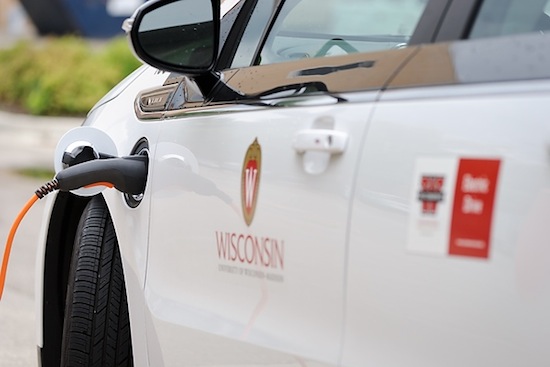Campus car fleet evolves with changing needs, technology

A Chevy Volt electric-drive vehicle charges while parked at the UW Car Fleet lot.
Photo: Jeff Miller
In an age of increasing awareness of sustainability and a “greening” campus, the university’s vehicle fleet has also been changing with the times.
What does a sustainable fleet look like? To Jim Bogan, whatever gets the jobs done most efficiently. For UW–Madison, that means a mix of electric drive and fuel-powered low-speed vehicles, hybrid vehicles, biodiesel trucks, and a slew of good old-fashioned pickup trucks and minivans.
As the man in charge of the campus fleet, Bogan’s job is to balance the diverse – and constantly changing – vehicle needs of the university community, from ferrying students to off-campus research sites to hauling equipment to cleaning building windows. He works to meet these demands while staying abreast of developing technologies and operating within the extensive — though often necessary, he acknowledges –— administrative rules of the state.
In 2006, the campus started using small electric drive low-speed vehicles (LSVs), with a maximum speed of around 25 miles per hour, intended for short trips primarily on campus roads. Though more expensive than comparably sized fuel-powered cars, these small, boxy vehicles produce less noise and lower emissions. “The way I look at it, we’re buying some clean air by using those. I don’t know how to put a price on that,” Bogan says.
Over the years, users have found that the electric LSVs work well for some purposes but not others. For example, conversion of battery energy to heat and cooling is relatively inefficient, making these vehicles ill-suited for applications that require staying in the car for long periods of time, such as parking enforcement. But Jon Lourigan, who manages low-speed vehicles for the Physical Plant Architects and Engineers unit, says this is not an issue for most of his users, many of whom prefer the performance of the electric vehicles. “We travel very short distances around campus and neither heating nor cooling take effect in that short time,” he says.
Changing technology has led Bogan more recently to new small combustion LSVs, which have higher power costs — gasoline rather than electricity — but offer better climate control and potentially more power for winter driving. “Initially some people were reluctant, but like anything else, change is difficult,” says Mike Gallardo, whose group with the Lab Animal Resources unit for the School of Medicine and Public Health has been happy with a switch from electric to fuel-powered vehicles a few months ago.
Finding the best fit often requires a willingness to experiment. “Let’s try the things out there that seem to be well-engineered solutions,” Bogan says. “Sometimes they work great, sometimes we won’t do that again. But if not for someone willing to go first and learn, how is it going to come out in the marketplace, and what are we if not a learning institution?”
They have expanded biodiesel capabilities to several fleet trucks, and the campus recently acquired a Chevy Volt to evaluate how electric cars — a technology expected to become more common on the market over time — can work in a fleet setting.
“Sometimes when you try out new things you get unexpected benefits,” Bogan says, mentioning a hybrid electric bucket truck, which can run the bucket with the engine off. “We were trying to get lower emissions, but turns out there’s an even better benefit for the user: enhanced safety, peace of mind, and satisfaction with the job.”
